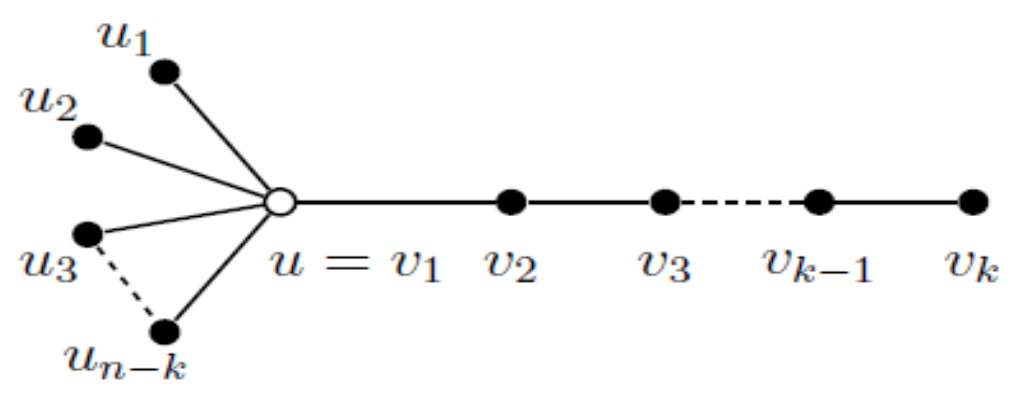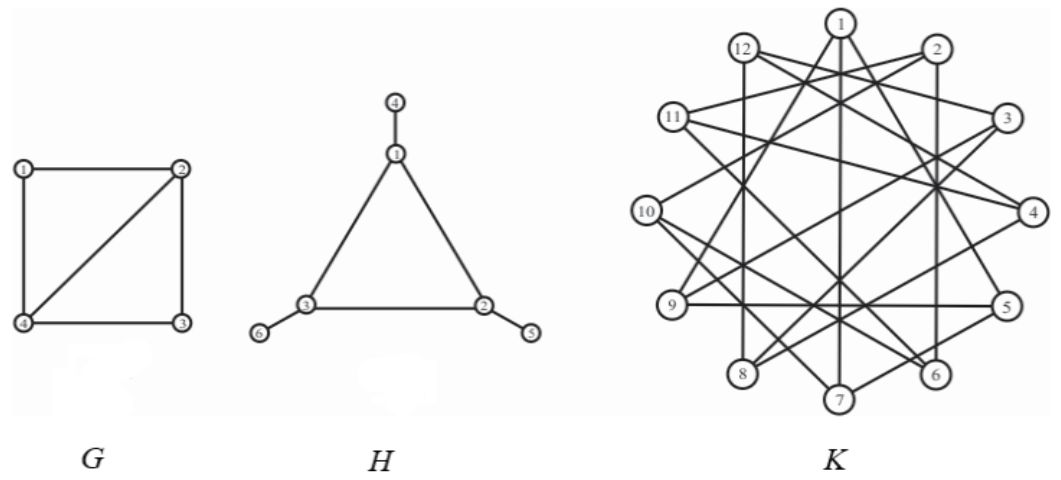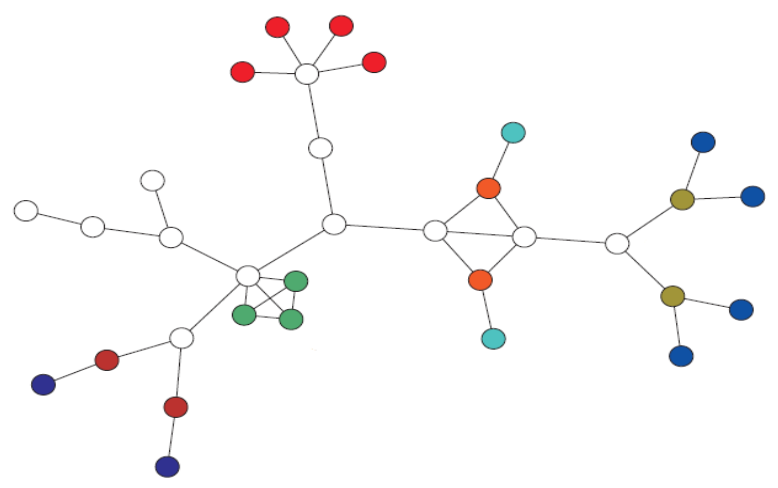On the Roots of the Modified Orbit Polynomial of a Graph
Abstract
1. Introduction
2. Preliminaries
Orbit Polynomial
3. Methods and Results
Roots of Orbit-Polynomial
- Case (1)
- If , then and by putting , we have when and so all roots are in .
- Case (2)
- If , thenFor we have . This means that for all roots of F are in . This completes the proof.
- (1)
- For each , has exactly a unique real root in .
- (2)
- If is the sequence of roots of ’s, then tends to if n is sufficiently large.
- (1)
- Since the number of sign changes in is one, the Descartes rule of signs yields that has at most one positive root. On the other hand, and , by using Mean Value Theorem, we conclude that for each n, has a root in .
- (2)
- Suppose is a real root of . We have
4. Applications
5. Summary and Conclusions
Author Contributions
Funding
Institutional Review Board Statement
Informed Consent Statement
Data Availability Statement
Conflicts of Interest
References
- Hosoya, H. Topological index, A newly proposed quantity characterizing the topological nautre of structural isomers of saturated hydrocarbons. Bull. Chem. Soc. Jpn. 1971, 44, 2332–2339. [Google Scholar] [CrossRef]
- Hosoya, H. On some counting polynomials in chemistry, Applications of graphs in chemistry and physics. Discrete Appl. Math. 1988, 19, 239–257. [Google Scholar] [CrossRef]
- Hosoya, H. Clar’s aromatic sextet and sextet polynomial. Top. Curr. Chem. 1990, 153, 255–272. [Google Scholar]
- Farrell, E.J. An introduction to matching polynomials. J. Comb. Theory 1979, 27, 75–86. [Google Scholar] [CrossRef]
- Gutman, I.; Harary, F. Generalizations of the matching polynomial. Utilitas Math. 1983, 24, 97–106. [Google Scholar]
- Gutman, I.; Hosoya, H. Molecular graphs with equal Zcounting and independence polynomials. Z. Naturforsch 1990, 45, 645–648. [Google Scholar] [CrossRef]
- Gutman, I. Some analytical properties of the independence and matching polynomials. Match Commun. Math. Comput. Chem. 1992, 28, 139–150. [Google Scholar]
- Stevanović, D.; Motoyama, A.; Hosoya, H. King and domino polynomials for polyomino graphs Graph Theory Notes. J. Math. Phys. 1977, 34, 31–36. [Google Scholar]
- Balasubramanian, K.; Ramaraj, R. Computer generation of king and color polynomials of graphs and lattices and their applications to statistical mechanics. J. Comput. Chem. 1985, 6, 447–454. [Google Scholar] [CrossRef]
- Farrell, E.J.; De Matas, C.M. On star polynomials of complements of graphs. Ark. Mat. 1989, 26, 85–190. [Google Scholar] [CrossRef]
- Farrell, E.J.; De Matas, C.M. Star polynomials of some families of graphs with small cyclomatic numbers. Util. Math. 1988, 33, 33–45. [Google Scholar]
- Dong, F.M.; Koh, K.M.; Teo, K.L. Chromatic Polynomials and Chromaticity of Graphs; World Scientific Publishing Co. Pte. Ltd: Hackensack, NJ, USA, 2005. [Google Scholar]
- Ghorbani, M.; Dehmer, M.; Rajabi-Parsa, M.; Emmert-Streib, F.; Mowshowitz, A. Hosoya entropy of fullerene graph. Appl. Math. Comput. 2019, 352, 88–98. [Google Scholar] [CrossRef]
- Balasubramanian, K. On Graph Theoretical Polynomials in Chemistry. In Mathematical and Computational Concepts in Chemistry; Trinastić, N., Ed.; Ellis Horwood Ltd.: New York, NY, USA, 1986; pp. 20–33. [Google Scholar]
- Dehmer, M.; Chen, Z.; Emmert-Streib, F.; Mowshowitz, A.; Varmuzag, K.; Jodlbauer, H.; Shih, Y.; Tripathi, S.; Tao, J. The orbit-polynomial: A novel measure of symmetry in graphs. IEEE Access 2020, 8, 36100–36112. [Google Scholar] [CrossRef]
- Dehmer, M.; Chen, Z.; Emmert-Streib, F.; Mowshowitz, A.; Shih, Y.; Tripathi, S.; Zhang, Y. Towards detecting structural branching and cyclicity in graphs: A polynomial-based approach. Inf. Sci. 2019, 471, 19–28. [Google Scholar] [CrossRef]
- Dehmer, M.; Shi, Y.; Mowshowitz, A. Discrimination power of graph measures based on complex zeros of the partial Hosoya polynomial. Appl. Math. Comput. 2015, 250, 352–355. [Google Scholar] [CrossRef]
- Dehmer, M.; Illić, A. Location of zeros of Wiener and distance polynomials. PLoS ONE 2012, 7, e28328. [Google Scholar] [CrossRef]
- Ellis-Monaghan, J.A.; Merino, C. Graph polynomials and their applications I: The Tutte polynomial. In Structural Analysis of Complex Networks; Dehmer, M., Ed.; Birkhäuser: Boston, MA, USA; Basel, Switzerland, 2010; pp. 219–255. [Google Scholar]
- Ghorbani, M.; Dehmer, M.; Cao, S.; Tao, J.; Streib, F. On the zeros of the partial Hosoya polynomial of graphs. Inf. Sci. 2020, 524, 199–215. [Google Scholar] [CrossRef]
- Tikoo, M.L. Location of the zeros of a polynomial. Am. Math. Mon. 1967, 74, 688–690. [Google Scholar] [CrossRef]
- Zilovic, M.S.; Roytman, L.M.; Combettes, P.L.; Swamy, M.N. A bound for the zeros of polynomials. IEEE Trans. Circuits Syst. I. 1992, 39, 476–478. [Google Scholar] [CrossRef]
- Ghorbani, M.; Dehmer, M.; Emmert-Streib, F. On the degeneracy of the orbit polynomial and related graph polynomials. Symmetry 2020, 12, 1643. [Google Scholar] [CrossRef]
- Ghorbani, M.; Dehmer, M. twork Analyzing by the Aid of Orbit Polynomial. Symmetry 2021, 13, 801. [Google Scholar] [CrossRef]
- Ghorbani, M.; Jalali-Rad, M.; Dehmer, M. Orbit Polynomial of Graphs versus Polynomial with Integer Coefficients. Symmetry 2021, 13, 710. [Google Scholar] [CrossRef]
- Ghorbani, M.; Dehmer, M.; Rajabi-Parsa, M.; Mowshowitz, A.; Emmert-Streib, F. On Properties of Distance-Based Entropies on Fullerene Graphs. Entropy 2019, 21, 482. [Google Scholar] [CrossRef]
- Ghorbani, M.; Dehmer, M.; Mowshowitz, A.; Emmert-Streib, F. The Hosoya entropy of graphs revisited. Symmetry 2019, 11, 1013. [Google Scholar] [CrossRef]
- Mowshowitz, A. Entropy and the complexity of graphs: I. An index of the relative complexity of a graph. Bull. Math. Biophys. 1968, 30, 175–204. [Google Scholar] [CrossRef]
- Mowshowitz, A. Dehmer, M. The Hosoya entropy of a graph. Entropy 2015, 17, 1054–1062. [Google Scholar] [CrossRef]
- MacArthur, B.D.; Sánchez-García, R.J.; Anderson, J.W. Symmetry in complex networks. Disc. Appl. Math. 2008, 156, 3525–3531. [Google Scholar] [CrossRef]
- Dehmer, M.; Emmert-Streib, F.; Mowshowitz, A.; Ilić, A.; Chen, Z.; Yu, G.; Feng, L.; Ghorbani, M.; Varmuza, K.; Tao, J. Relations and bounds for the zeros of graph polynomials using vertex orbit. Appl. Math. Comput. 2020. [Google Scholar] [CrossRef]
- Brown, J.I.; Mol, L.; Oellermann, O.R. On the roots of Wiener polynomials of graphs. Discrete Math. 2008, 341, 2398–2408. [Google Scholar] [CrossRef]



| Biological Networks | n | ||
|---|---|---|---|
| Biological Networks | |||
| Human B Cell Genetic | 5.930 | ||
| Caenorhabditis elegans Genetic | 2.060 | ||
| BioGRID Human | 7.013 | ||
| BioGRID Saccharomyccs cerevisiae | 5.29 | ||
| BioGRID Drosophila | 7.371 | ||
| BioGRID Mus musculus | 209 | ||
| Yeast Protein Interactions | 1.458 | ||
| c. elegans metabolic | 453 | ||
| Technological networks | |||
| Internet | 22.332 | ||
| US Power Grid | 4.941 | ||
| US Airports | 332 | ||
| www California search subnet | 5.925 | ||
| www EPA.gov subnet | 4.253 | ||
| www Political Blogs | 1.222 | ||
| Social networks | |||
| 1.133 | |||
| Media ownership | 4.475 | ||
| Geometry Co-authorship | 3.621 | ||
| Erdös Collaboration | 6.927 | ||
| PhD network | 1.025 |
Publisher’s Note: MDPI stays neutral with regard to jurisdictional claims in published maps and institutional affiliations. |
© 2021 by the authors. Licensee MDPI, Basel, Switzerland. This article is an open access article distributed under the terms and conditions of the Creative Commons Attribution (CC BY) license (https://creativecommons.org/licenses/by/4.0/).
Share and Cite
Ghorbani, M.; Dehmer, M. On the Roots of the Modified Orbit Polynomial of a Graph. Symmetry 2021, 13, 972. https://doi.org/10.3390/sym13060972
Ghorbani M, Dehmer M. On the Roots of the Modified Orbit Polynomial of a Graph. Symmetry. 2021; 13(6):972. https://doi.org/10.3390/sym13060972
Chicago/Turabian StyleGhorbani, Modjtaba, and Matthias Dehmer. 2021. "On the Roots of the Modified Orbit Polynomial of a Graph" Symmetry 13, no. 6: 972. https://doi.org/10.3390/sym13060972
APA StyleGhorbani, M., & Dehmer, M. (2021). On the Roots of the Modified Orbit Polynomial of a Graph. Symmetry, 13(6), 972. https://doi.org/10.3390/sym13060972







